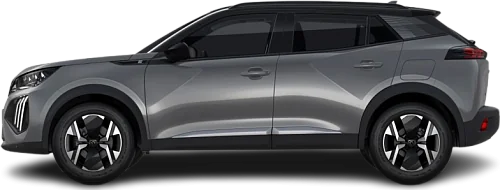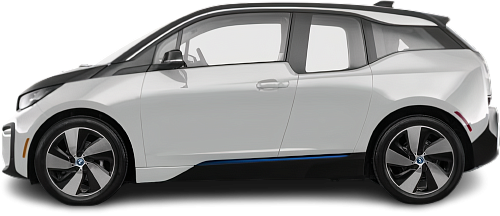Global EV Comparison: Peugeot e-2008 54 kWh vs BMW i3 BEV 60 Ah
Struggling to Decide? Let AI Help!
Your AI Summary Is Ready!
General Info
The Peugeot e-2008 54 kWh (2023-…) is currently produced, it has a starting price of €40000. The BMW i3 BEV 60 Ah (2013-2017) has been discontinued. You can find it for as low as €11200 on the used car market.
The Peugeot e-2008 54 kWh (2023-…) is a SUV, whereas the BMW i3 BEV 60 Ah (2013-2017) is a Hatchback.
| Property | Peugeot e-2008 54 kWh | BMW i3 BEV 60 Ah |
|---|---|---|
| Years of Production | 2023-… | 2013-2017 |
| Current Status | Produced | Discontinued |
| Country of Manufacture | China, Spain | Germany |
| Body Style | SUV | Hatchback |
| Market Availability | EU | EU, USA |
| Price Europe (New) | €40000 | - Price Europe (New) |
| Price Europe (Used) | €32900 | €11200 |
| GCC Score | 5.5 | 4.9 |
Range and Efficiency
While the Peugeot e-2008 54 kWh (2023-…) offers a longer real-world range and a bigger battery, it is less energy-efficient than the BMW i3 BEV 60 Ah (2013-2017).
| Property | Peugeot e-2008 54 kWh | BMW i3 BEV 60 Ah |
|---|---|---|
| Range (EPA) | - Range (EPA) | 130 km |
| Range (WLTP) | 406 km | - Range (WLTP) |
| Range (GCC) | 345 km | 133 km |
| Battery Capacity (Nominal) | 54 kWh | 21.6 kWh |
| Battery Capacity (Usable) | 50.8 kWh | 18.8 kWh |
| Efficiency per 100 km | 14.7 kWh/100 km | 14.1 kWh/100 km |
| Efficiency per kWh | 6.79 km/kWh | 7.07 km/kWh |
| Range and Efficiency Score | 7.1 | 5.7 |
Charging
Both vehicles utilize a standard 400-volt architecture.
The Peugeot e-2008 54 kWh (2023-…) offers faster charging speeds at DC stations, reaching up to 100 kW, while the BMW i3 BEV 60 Ah (2013-2017) maxes out at 50 kW.
Both vehicles are equipped with the same on-board charger, supporting a maximum AC charging power of 7.4 kW.
| Property | Peugeot e-2008 54 kWh | BMW i3 BEV 60 Ah |
|---|---|---|
| Max Charging Power (AC) | 7.4 kW | 7.4 kW |
| Max Charging Power (DC) | 100 kW | 50 kW |
| Architecture | 400 V | 400 V |
| Charge Port | CCS Type 2 | CCS Type 2 |
| Charging Score | 4.4 | 3.8 |
Performance
The BMW i3 BEV 60 Ah (2013-2017) is rear-wheel drive, while the Peugeot e-2008 54 kWh (2023-…) offers a front-wheel drive system.
The BMW i3 BEV 60 Ah (2013-2017) boasts greater motor power and accelerates faster from 0 to 100 km/h.
| Property | Peugeot e-2008 54 kWh | BMW i3 BEV 60 Ah |
|---|---|---|
| Drive Type | FWD | RWD |
| Motor Type | PMSM | PMSM |
| Motor Power (kW) | 115 kW | 125 kW |
| Motor Power (hp) | 154 hp | 168 hp |
| Motor Torque | 260 Nm | 250 Nm |
| 0-100 km/h | 9.1 s | 7.2 s |
| Top Speed | 150 km/h | 150 km/h |
| Performance Score | 2.9 | 3.2 |
Dimensions
The Peugeot e-2008 54 kWh (2023-…) has a longer body, while the BMW i3 BEV 60 Ah (2013-2017) stands taller, offering a more elevated ride. Their widths are almost identical, so both offer a similar amount of shoulder room.
Both models have similar wheelbase lengths.
| Property | Peugeot e-2008 54 kWh | BMW i3 BEV 60 Ah |
|---|---|---|
| Length | 4304 mm | 3999 mm |
| Width (with Mirrors) | 1987 mm | 2039 mm |
| Width (w/o Mirrors) | 1775 mm | 1775 mm |
| Height | 1523 mm | 1578 mm |
| Wheelbase | 2562 mm | 2570 mm |
Cargo and Towing
The Peugeot e-2008 54 kWh (2023-…) provides more cargo capacity, featuring both a larger trunk and more space with the rear seats folded.
Neither car is equipped with a frunk (front trunk).
Neither vehicle is officially rated for towing in in the EU.
| Property | Peugeot e-2008 54 kWh | BMW i3 BEV 60 Ah |
|---|---|---|
| Number of Seats | 5 | 4 |
| Curb Weight | 1623 kg | 1270 kg |
| Cargo Volume (Trunk) | 434 l | 260 l |
| Cargo Volume (Max) | 1467 l | 1100 l |
| Cargo Volume (Frunk) | - Cargo Volume (Frunk) | - Cargo Volume (Frunk) |
| Towing Capacity | - Towing Capacity | - Towing Capacity |
| Cargo and Towing Score | 5.3 | 4.2 |




